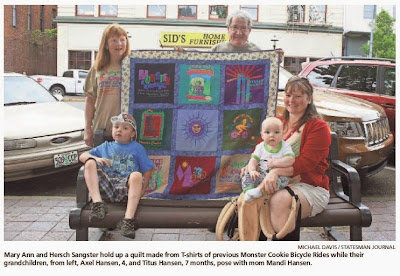Though there is no new bike announcement or project on the agenda for Council on Monday, by our standards there is an extraordinary density of bike-related informational stuff on the agenda. It's nice to see!
But most important is
the report on Marine Drive.
 |
| Marine Drive and proposed bike park |
You may recall that
Councilor Lewis had asked for more information on Marine Drive. Here's some good news!
Because of the similar alignments of the proposed
Marine Drive NW and the SRX [Salem River Crossing OR-22 connector], the Marine Drive project is largely on hold until the SRX
public process is completed and the Record of Decision is issued. This is because any
work done on Marine Drive NW that could be construed as part of the SRX project,
which is done prior to the Record of Decision, could open the SRX project to a federal
lawsuit for violation of the National Environmental Policy Act process.
So, that's good to know.
Interestingly - but carefully kept separate - there is also
a report on a grant application for the Wallace bike park. Council will also "apply for...the Oregon Parks and Recreation Department Local Government Grant for the purpose of constructing a bike park facility at Wallace Marine Park." The urban highway would skirt the park and affect access, and park advocates do themselves a disservice by omitting this fact from discussion.
There's also an intergovernmental agreement with Oregon Parks and Rec for
maintenance on the Willamette Valley Scenic Bikeway signs.
The scenic bikeway comes up again in
the brief report on bike boulevards. Staff intend to apply for a TGM grant to plan in detail a pilot bike boulevard along the Winter/Maple alignment, and the fact that the Willamette Valley Scenic Bikeway uses this alignment is adduced as a reason to start with this route. (But isn't the route going to get realigned after the Minto Bridge opens?) I wish the project were more comprehensive and entailed a city-wide commitment to bike boulevards rather than merely a pilot project. There's something bloodless and tentative about the report and TGM grant proposal. At this point, what is experimental about bike boulevards? Many communities have already piloted and implemented them. We should be going full speed ahead not just dipping our tippy-toes into the pool!
There's
another intergovernmental agreement for the bike counters on the Union Street RR Bridge and Courtney Minto Bridge. They're packaged in a larger IT project with traffic signal controllers and ethernet switches. (See
here and
here for history on this.)
And
a no-bid agreement with Union Pacific for two more crossings on Woodrow Street and Silverton Road for an extension of the "Quiet Zone."
The crossing at Chemeketa has been less problematic than I thought it would be - but I detest the crossing at Mill Street (thoughts
here and
here). At many of the crossings, the addition of sharrows is helpful if you are confident in taking the lane, but if you are not a confident rider the lane narrowing seems perilous and probably pushes you onto the sidewalk. Overall, I think I am neutral on the crossings as they affect people on foot and on bike (apart from the auditory issue for neighbors). They are not as harmful as I feared, but they aren't actually all that helpful: They "help" the railroad with liability, not other road users with connectivity. More importantly, they might also represent a missed opportunity to rethink and radically reconfigure the crossings better to serve all users. In any case, they don't seem worth drilling into or dwelling on.
Looking to the future, on Tuesday, May 26th, the Goodwill project will appear in a month for a Public Hearing:
Petition to Vacate A Portion of First Street NW and Lincoln Avenue NW. (Details
here and
here.) On
the same date before Council formally meets there will be a work session on the
West Salem Business District Plan, and that will surely touch on the
undercrossing proposed for Second Street at Wallace Road. (See
here and
here.) Together these projects could transform an area and create connections where things are currently a huge barrier for people on bike and on foot.
(How great is it to have a large section here devoted just to bikey things!)









 Did you see the Sangster family quilt in the paper yesterday?!
Did you see the Sangster family quilt in the paper yesterday?!











.jpg)





















